- Submissions

Full Text
COJ Nursing & Healthcare
3D printing of a Lowell Makes mask in PLA
Nidal Elmoutawakkil1*, Alae Eddine Seffar2, Dalal Elmoutawakkil3, Nabil Hacib4 and Samira Bellemkhannate5
13rd Year Resident in the Removable Prosthodontic Department at the D.C.T.C of Casablanca, Morocco
23rd Year Resident in the Department of Urology at the ibn Rochd University Hospital Casablanca, Morocco
3,4Specialist in Orthodontics and Implantology working in the Private sector in Casablanca, Morocco
5Head of the Removable Prosthodontic Department at the D.C.T.C of Casablanca, Morocco
*Corresponding author: Nidal Elmoutawakkil, 3rd Year Resident in the Removable Prosthodontic Department at the D.C.T.C of Casablanca, Morocco
Submission: May 7, 2021Published: September 27, 2021

ISSN: 2577-2007Volume7 Issue4
Abstract
The new pandemic crisis caused by the Covid 19 virus has led to a global shortage of personal protective equipment including FFP2 masks necessary for the exercise of professionals in direct contact with positive patients. The following article reports the 3D printing of a PLA mask similar to the FFP2 mask to which we have added a ULPA filter.
Keywords: Lowel makes mask; PLA; 3D printing; ULPA filter
Introduction
In the context of the new pandemic caused by the COVID-19 virus, the quarantine measures adopted have raised tensions and fears among the general public; A reckless consequence of this is the impulse purchase of personal protective equipment (PPE), leaving the health professionals who need it most in short supply; Besides, facing the globally declared quarantine state, the factories responsible for manufacturing this equipment have suspended their activity as well as their export. This is how members of the global 3D printing community embarked on the design of several reusable PPE with interchangeable filters, mainly manufactured using high-temperature filament extrusion office printers, the cost of which remains reduced. Until today, the PPE that is still needed mainly includes surgical masks, FFP2 masks, and respiratory hood switch-controlled air purification. However, since this PPE is intended to be reusable, careful consideration should be given to compatibility with available disinfection techniques while ensuring that all such devices are monitored on an ongoing basis for tightness and condition before each use.
To ensure the best fit, customization of these masks can be achieved in several ways:
i. by printing several sizes
ii. by experimenting with flexible materials
iii. by surface scanning the faces to virtually adjust these masks on an individual basis.
Although this individualized approach may limit the production throughput, the improvement in final rendering and wearing comfort may justify this impact on throughput [1].
A 2004 study conducted by the National Institute for Occupational Safety and Health, involving 3,997 heads and a second study in 2005 suggesting a workplace protection factor (WPF) for respiratory masks, found together that there were substantial and significant differences between the effectiveness of one-size-fits-all face masks. The WPF regression analysis found the most important of the 12 facial dimensions to be bigonial width, face width (bizgomatic width), face length (chin-saddle length), and nose protrusion. (Figure 1) Although not formally tested, the 2005 data was almost normally distributed
and suggested a basis for three potential mask size. For the design
of our model, we opted for a medium to large size mask for testing.
(Chin-Sellion = 132mm, bigonial = 96mm, nose = 43mm) [2].
Figure 1: Diagram of the four major metric values for the adaptation of the mask [3].
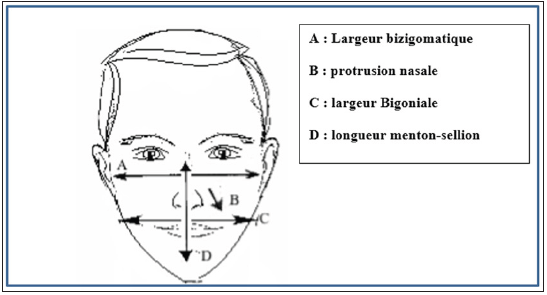
Nowadays, there are several versions of 3D printed masks, in
parallel, The “FDA” (administration of food and drugs), the “NIH”
(the national institute of health), and the “United States Veterans
Association” are working together to validate and certify several
prototypes of FFP2 masks, some of which are currently being tested.
In the meantime, and on a more individual scale, many designs of face
masks have been proposed and tested by researchers, physicians,
and commercial entities with varying degrees of success. In any
case, end users should clearly understand that only prototypes are
available at this point and that they must pass several fit tests to
assess their quality as PPE.
3D printing transmits a digital file to an additive manufacturing
device such as a 3D printer to create a three-dimensional solid
object layer by layer. Digital files are often made available to the
general community in the creator’s space in “STL”, “OBJ” or even
“CAD” formats. Digital files are processed, edited, and prepared in
software such as “GrabCAD”, “Meshmixer”, “iiiSlic3r” and “Meshlab”.
The Copper3D NanoHack Mask [3-6] illustrates the limitations
of community-generated designs and wants design improvements
based on local testing. This mask can be printed with a polylactic
acid (PLA) filament as a flat part and is intended to be then
manually assembled into its final three-dimensional configuration
after heating to 55 to 60 °C (131 to 140 F°) by forced hot air (e.g., a
Hairdryer) or by immersing it in hot water (Figure 2). In particular,
all joints should be manually sealed to ensure an airtight fit. The
mask features a simple air inlet port into which two reusable filters
can be inserted, with a screw cap to hold them in place. This design
has several drawbacks, due to its flat architecture, only one mask
can be printed by most desktop printers at a time, which limits the
throughput of manufacturing. Practically, initial tests have shown
difficulty in folding these masks created using conventional PLA
filament, with large gaps along the hard-to-mitigate knuckles. If
sealed successfully, the mask may provide limited airflow for some
users and a second breathing port can be envisioned by mirroring
the first port on the design software. Due to these multiple
limitations, this mask is currently undergoing revisions by the
original designer.
Figure 2: NanoHack Copper3D mask model [4].
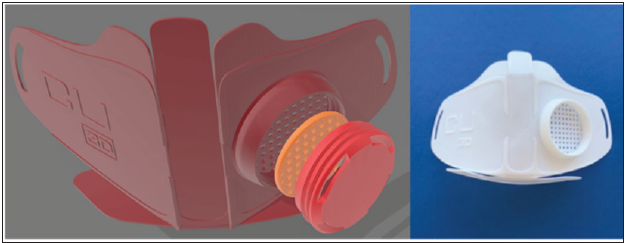
The Thingiverse Kvatthro [5] user-designed HEPA mask can also be fabricated using most desktop printers. PLA filament is suggested due to the ability to adapt the mask to the individual wearer after exposure to heat, which is important to ensure the best possible seal under working conditions. This device is available in male and female versions and leaves room to insert an interchangeable HEPA filter into a port on the front of the mask (Figure 3). A similar design has been proposed by the Chinese company Creality [6], with a different configuration of the filter holder, intended for the insertion of layers of folded tissue or filters (Figure 4).
Figure 3: HEPA mask design with a box for inserting the filter [5].
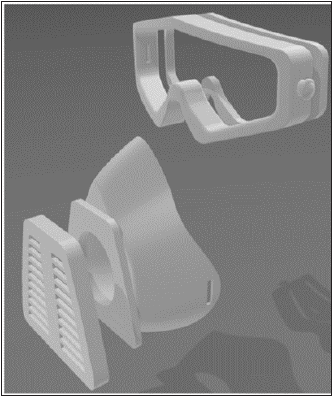
Figure 4: Crealitymask and goggles design [6].

The Lowell Makes mask is a variation of the replaceable front filter design which offers the advantage of printing without supports or adhesion [7] (Figure 5). Although these masks are an alternative to FFP2 masks, they are not approved by the “FDA” or “NIOSH” or any other federal or state regulatory agency; They should not be considered as replacing an FFP2 mask, especially if the latter is available [8].
Figure 5: Lowell Makes mask design, with the filter held in place by a grid inside the mask and a cap on the front of the mask [7].
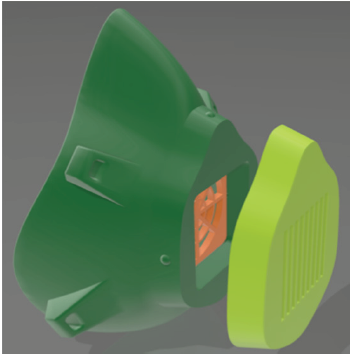
Material and Method
The designed mask is based on the general morphology of the FFP2 standard, this is how we downloaded the prototype of the “Lowell Makes” mask available on the platform of the same firm, we have adapted this prototype to our craniofacial dimensions. on the “Meshmixer” software, to finally export the prototype in STL format to print it by fused deposition modeling (FDM) via the printer available in the department of removable prosthodontics in the dental consultation and treatment center of Casablanca (Figure 6).
Figure 6: Adaptation of the Lowell Makes mask prototype to our facial proportions [7].
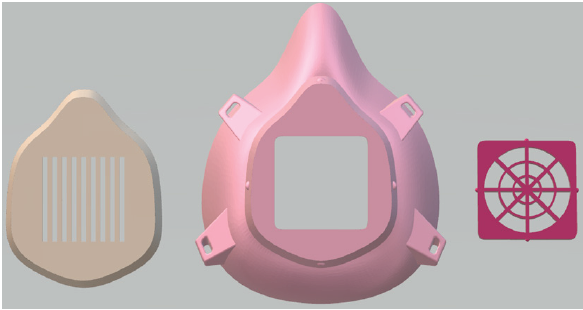
Result
After exporting the STL file of each element making up the mask (the cover, the body of the mask, and the retentive filter grid) to the “XYZ Junior 1.0” 3D printer equipped with a PLA (polylactic acid) filament, the total duration of the printing of the full mask was around 4h30 min; the final rendering of the mask being smooth and free of any artifact, no finishing took place (Figure 7). Regarding the choice of the filter, we opted for two solutions, the first to cut an FFP2 mask and to use the parts obtained as being filters (doubled), the second being a commercial ULPA or HEPA filter cut from a sold coil. in large surfaces specializing in air filtration (Figure 8).
Figure 7: Placement of the HEPA filter in the Lowells Makes mask printed in PLA cut from a coil.

Figure 8: Additional fixing of the cover using office tacks and addition of a heavy silicone flexible seal to the Lowells Makes mask printed in PLA.

HEPA (high-efficiency particulate air) filtration is a standard
developed by the United States Energy Commission. HEPA filters
are the world’s most efficient way to filter the air from dirt, pollens,
bacteria, and any particle in the air larger than 0.3μm. They are
used in hospitals, pharmaceutical companies, laboratories, and
electronics companies to remove all fine dust. To qualify as HEPA, a
filter must remove 99.97% of 0.3-micron particles.
A ULPA (Ultra Low Penetration Air) filter can theoretically filter
dust, pollen, and bacteria from the air with an efficiency of 99.999%
thanks to a size of 0.1 microns. Remember that the average size of
the Covid-10 virus is around 0.1μm and that the porosity of the
FFP2 mask allows particles to be filtered with a diameter of around
0.6μm at 94%.
In order to maximize the filtering effect while wearing this
mask, we opted for the interposition of a ULPA filter (U15, U 17)
covered by an FFP2 filter. We tested the tightness of this mask by
checking for side leaks by maintaining a stabilized sheet on the
outer cover by suction during inhalation, to maximize this seal the
two filters were taped to the outer face of the orifice of the mask.
mask and the cover were fixed with tacks (Figure 8).
Finally, to make it easier to wear the mask, we attached elastic
bands to it in two ways, first putting an elastic on each side (left and
right) to wear it around the outer pavilion of the ears, however, this
method caused lesions and injuries to the ears, the second method
being to adapt the length to the coronal diameter and to have an
elastic band per side (top and bottom) making sure to cross them
during the wearing, this last method not only makes wearing the
mask easier but also facilitates also its implementation for veiled
personnel.
We have also added to the edges of the mask in contact with
the face a peripheral silicone seal, polymerized on the face, to avoid
any marks or scars after removal of this mask while increasing the
comfort of the practitioner
Discussion
The French society of hospital hygiene (HF2H) as well as
the WHO recommends changing the FFP2 mask after 8 hours
of wearing or each time it is wet, taking into account the global
shortage incurred during the past few months following the
pandemic caused by the Covid-19 virus, the medical staff had to
make reusable masks ready for disinfection [9].
The protocol that we chose by superimposing two filters (the
first having a porosity of 0.6μm and the second of 0.1μm) allowed
us to potentiate the filtration while ensuring the judicious use of
PPE, in fact instead of wearing conventionally the FFP2 mask for 8
hours, the decomposition of the latter offered 5 doubled portions
allowing us to use it for 40 hours.
The disinfection of the mask begins with its disassembly on an
operating field, the filters are discarded the external and internal
surfaces are disinfected by spraying with 5% hypochlorite or using
a surface disinfectant based on quaternary ammonium, the mask
is then wiped and stored in a special box, taking into account the
degradation of the PLA in contact with water, immersion remains
prohibited.
The price of the mask (without filter) is 4€, in fact, a spool of
PLA, costing on average 60€, allows the printing of 15 reusable
masks. A ULPA filter costs about $50 to make 10 individual filters;
Thus, the total cost price of the mask is around 9€.
Conclusion
The “Open Source” community makes it possible to popularize 3D printing while making it easier for any 3D printer owner to appropriate their protective equipment at a reduced price, however, intellectual property remains a concern, in particular for medical parts that cannot be procured promptly during a pandemic crisis similar to that caused by the covid19 virus. The lack of clinical experience requires the implementation of a codified protocol to scientifically test the validity of these 3D printed medical devices with the aim of future certification putting them on the same footing as FFP2/FFP3 masks.
References
- Ramanathan K, Antognini D, Combes A, Paden M, Zakhary B (2020) Planning and provision of ECMO services for severe ARDS during the COVID-19 pandemic and other outbreaks of emerging infectious diseases. Lancet Respir Med S2213-2600(20): 30121.
- Ziqing Z, Coffey C, Roland BA (2005) The effect of subject characteristics and respirator features on Respirator Fit. J Occup Envir H 2(12): 641-649.
- Provenzano D, Rao YJ, Mitic K, Obaid SN, Pierce D, et al. (2020) Rapid Prototyping of Reusable 3D-Printed N95 Equivalent Respirators at the George Washington University. Preprints 4(1): 1-9.
- https://copper3d.com/hackthepandemic/
- https://www.thingiverse.com/thing:4222563
- https://creality.com/info/makers-guide-3d-printed-face-mask-no-worries-on-mask-shortage-and-virus-infection-i00248i1.html
- https://lowellmakes.com/covid-19-response/
- Tino R, Moore R, Antoline S, Prashanth Ravi, Nicole Wake, et al. (2020) COVID-19 and the role of 3D printing in medicine. 3D Print Med 6: 11.
- French Society of Hospital Hygiene (SF2H) (2020) Relating to the indications for wearing surgical masks and respiratory protection devices of the FFP2 type for healthcare professionals.
© 2021 Nidal Elmoutawakkil. This is an open access article distributed under the terms of the Creative Commons Attribution License , which permits unrestricted use, distribution, and build upon your work non-commercially.
 a Creative Commons Attribution 4.0 International License. Based on a work at www.crimsonpublishers.com.
Best viewed in
a Creative Commons Attribution 4.0 International License. Based on a work at www.crimsonpublishers.com.
Best viewed in 







.jpg)






























 Editorial Board Registrations
Editorial Board Registrations Submit your Article
Submit your Article Refer a Friend
Refer a Friend Advertise With Us
Advertise With Us
.jpg)






.jpg)














.bmp)
.jpg)
.png)
.jpg)










.jpg)






.png)

.png)



.png)






